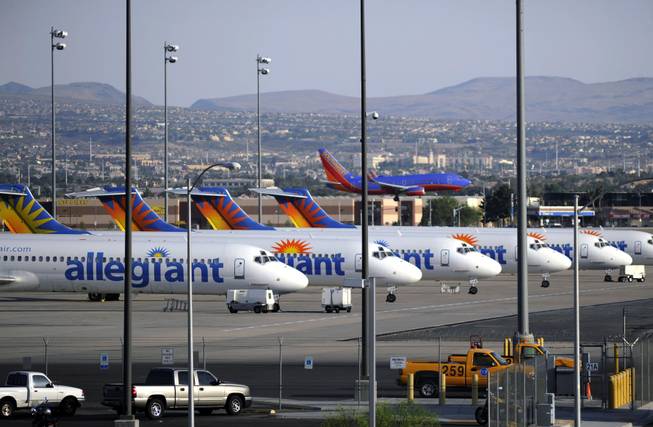
David Becker / AP
In this Thursday, May 9, 2013, photo, a Southwest airliner comes in for a landing as a row of Allegiant Air jets are parked at McCarran International Airport in Las Vegas.
Published Monday, July 1, 2013 | 1:36 p.m.
Updated Monday, July 1, 2013 | 4:20 p.m.
WASHINGTON — Five near collisions — four of them last year — involving airliners that aborted landings prompted the National Transportation Safety Board to call Monday for changes in air traffic control procedures.
In a letter to the Federal Aviation Administration, the board said aborted landings are placing planes on converging flight paths, forcing pilots to execute evasive maneuvers at a low altitude to avoid a potential collision.
The board cited four such near collisions last year: two in Las Vegas, and one each in New York and Charlotte, N.C. There was also a similar near collision in Las Vegas in 2006. In each case, the pilot of at least one of the planes swiftly changed course to avoid a possible midair collision.
The FAA regulates safety and operates the national air traffic control system, while the board investigates accidents and safety incidents.
Aborted landings are not uncommon and can occur for many reasons, but such sudden changes in course can create the danger one plane will fly into the path of another plane that's taking off or landing.
McCarran International Airport in Las Vegas is especially at risk for such incidents because of runways that are angled so that the flights paths of planes taking off simultaneously can cross. In one of the incidents at McCarran on July 30, 2012, a Spirit Airlines Airbus A319 and a Cessna Citation 510 came within 100 feet vertically and about 1,000 feet laterally before the pilot of the smaller Cessna four-seater changed course to avoid the airliner. The airliner executed the aborted landing.
In another incident on the same day at John F. Kennedy International Airport in New York, an American Airlines Boeing 737 aborted a landing at the same time as a Pinnacle Airlines regional jet was taking off. The two planes were being handled by different air traffic controllers using different radio frequencies. The two planes came within about 1,600 feet laterally and 300 feet vertically.
In a third incident the same month in Charlotte, N.C., an Expressjet regional jet was executing an aborted landing at the same time an Air Wisconsin regional jet was taking off. The two planes were being guided by different controllers. The controller handling the Air Wisconsin flight alerted the pilot to the conflict with the other plane, but gave no instructions on how to avoid the potential collision. The two planes passed within less than 800 feet laterally and 400 feet vertically of each other.
A fourth incident occurred when a JetBlue Airbus A320 aborted a landing at McCarran on April 26, 2012, at the same time a Mexican-registered Learjet 60 was taking off. The JetBlue pilot turned sharply to avoid the Learjet, while the Learjet pilot initiated a rapid climb to avoid the airliner. Radar data showed the climb rate at 6,000 feet per minute immediately after departure. In radio transmissions from the pilot, the airplane's stick-shaker, a cockpit safety system, can be heard in the background warning the pilot of an imminent stall.
The only warning from the controller to the Learjet pilot was to "go low," but by the time the instruction was issued, the plane was climbing at a high rate and the pilot was unable to comply. The planes came within less than 1,600 feet laterally and 100 feet vertically of each other.
Another McCarran incident cited by the board occurred on Jan. 27, 2006, between a United Airlines Airbus A320 that was instructed by controllers to abort a landing because of a potential conflict with a Beechcraft BE200, a twin-engine turboprop. While attempting to circle around, the United plane nearly collided with an American Airlines Boeing 757 that was taking off.
The United pilot made "made an evasive turn to the right to avoid a potential collision, reportedly banking as much as 40 degrees to avoid crossing" the flight path of the American plane, the board said. The American plane also made a slight left turn away from the other plane.
Afterward, the United flight crew told investigators that "the tower controllers did not seem to have clear procedures for separating aircraft in the event of a go-around (aborted landing) and may not have had the same perception of an impending collision that they (the crew) did," the board's letter said.
The FAA said in a statement that the agency has "thoroughly investigated the incidents and took aggressive steps to address the causes."
"The FAA takes NTSB recommendations very seriously and will respond to the board within 90 days," the statement said.
Among the actions the agency has taken at McCarran is placing more air traffic managers on duty whose aim is to focus on conflicting flight paths, according to an FAA official who wasn't authorized to speak publicly and asked not to be named. The agency also is testing several new technologies aimed at alerting controllers to the potential for such collisions, the official said.

Join the Discussion:
Check this out for a full explanation of our conversion to the LiveFyre commenting system and instructions on how to sign up for an account.
Full comments policy